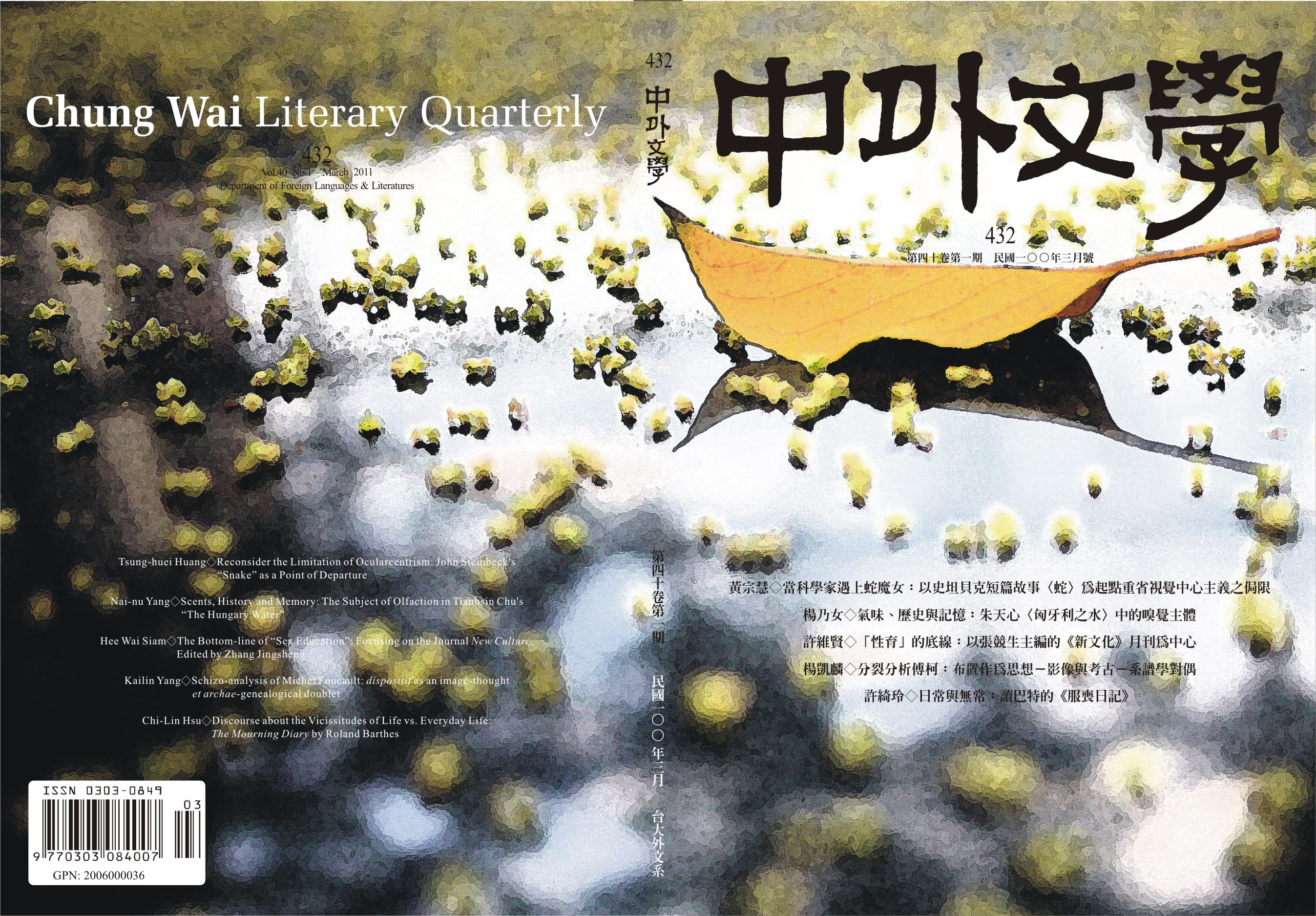第四十卷 第一期 總432 中華民國100年3月
Vol.40 No.1 March 2011

《中外文學》三月號收錄了五篇精彩論文:黃宗慧解析史坦貝克(John Steinbeck)的短篇故事〈蛇〉,重省視覺中心主義之侷限,並探索另類觀看方式的可能;楊乃女從嗅覺主體的角度討論朱天心的〈匈牙利之水〉,並處理其中歷史與記憶的相關問題;許維賢重探張競生主編的《新文化》月刊對「性育」的倡導,顯示其推動「知識/權力」對中國男女性別與性相的掌控;楊凱麟探討布置(dispositif)作為傅柯(Michel Foucault)的思想-影像如何構成一種風格化的思想運動;許綺玲則由日常生活母題切入,分析、審視巴特(Roland Barthes)悼母之《服喪日記》。
中外文學三月號目錄
Contents
黃宗慧╱當科學家遇上蛇魔女: 以史坦貝克短篇故事〈蛇〉為起點重省視覺中心主義之侷限
當科學家遇上蛇魔女
以史坦貝克短篇故事〈蛇〉為起點重省視覺中心主義之侷限
黃宗慧*
摘要
◎關鍵詞:史坦貝克,視覺中心主義,暗室,視覺,倫理
★國立臺灣大學外國語文學系教授。
Tsung-huei Huang╱Reconsider the Limitation of Ocularcentrism: John Steinbeck’s “Snake” as a Point of Departure
Reconsider the Limitation of Ocularcentrism
John Steinbeck’s “Snake” as a Point of Departure
Tsung-huei Huang*
Abstract
◎Keywords: John Steinbeck, ocularcentrism, camera obscura, vision, ethics
★ Professor, Department of Foreign Languages and Literatures, National Taiwan University.
楊乃女╱氣味、歷史與記憶: 朱天心〈匈牙利之水〉中的嗅覺主體
氣味、歷史與記憶
朱天心〈匈牙利之水〉中的嗅覺主體
楊乃女*
摘要
◎關鍵詞:〈匈牙利之水〉,嗅覺主體,記憶,氣味,歷史
★國立高雄師範大學英語系助理教授。
Nai-nu Yang╱Scents, History and Memory: The Subject of Olfaction in Tianhsin Chu’s “The Hungary Water”
Scents, History and Memory
The Subject of Olfaction in Tianhsin Chu’s “The Hungary Water”
Nai-nu Yang*
Abstract
◎Keywords: “The Hungary Water,” the subject of olfaction, memory, scents, history
★ Assistant Professor, Department of English, National Kaohsiung Normal University.
許維賢╱「性育」的底線: 以張競生主編的《新文化》月刊為中心
「性育」的底線
以張競生主編的《新文化》月刊為中心
許維賢*
摘要
◎關鍵詞:《新文化》,張競生,男性氣概,女性氣質,同性愛
★新加坡南洋理工大學中文系助理教授。
Hee Wai Siam╱The Bottom-line of “Sex Education”: Focusing on the Journal New Culture, Edited by Zhang Jingsheng
The Bottom-line of “Sex Education”
Focusing on the Journal New Culture, Edited by Zhang Jingsheng
Hee Wai Siam*
Abstract
◎Keywords: New Culture, Zhang Jingsheng, Masculinity, Femininity, Homosexuality
★Assistant Professor, Division of Chinese, Nanyang Technological University, Singapore.
楊凱麟╱分裂分析傅柯: 布置作為思想-影像與考古-系譜學對偶
分裂分析傅柯
布置作為思想-影像與考古-系譜學對偶
楊凱麟*
摘要
◎關鍵詞:米歇爾‧傅柯,布置,在己物,經驗-超驗對偶,系譜學
★國立台北藝術大學美術系副教授。
Kailin Yang╱Schizo-analysis of Michel Foucault: dispositif as an image-thought et archae-genealogical doublet
Schizo-analysis of Michel Foucault
dispositif as an image-thought et archae-genealogical doublet
Kailin Yang*
Abstract
◎Keywords: Michel Foucault, dispositif, thing in itself, empirical- transcendental doublet, genealogy
★Associate Professor, School of Fine Arts, Taipei National University of the Arts.
許綺玲╱日常與無常:讀巴特的《服喪日記》
日常與無常
讀巴特的《服喪日記》
許綺玲*
摘要
◎關鍵詞:羅蘭巴特,服喪,日常生活,互文性,紀念碑,日記
★國立中央大學法文系副教授。
Chi-Lin Hsu╱Discourse about the Vicissitudes of Life vs. Everyday Life: The Mourning Diary by Roland Barthes
Discourse about the Vicissitudes of Life vs. Everyday Life
The Mourning Diary by Roland Barthes
Chi-Lin Hsu*
Abstract
◎Keywords: Roland Barthes, mourning, everyday life, intertextuality, monument, diary
★ Associate Professor, Department of French, National Central University.
